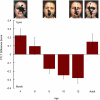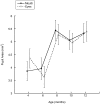Infants deploy selective attention to the mouth of a talking face when learning speech - PubMed (original) (raw)
Infants deploy selective attention to the mouth of a talking face when learning speech
David J Lewkowicz et al. Proc Natl Acad Sci U S A. 2012.
Abstract
The mechanisms underlying the acquisition of speech-production ability in human infancy are not well understood. We tracked 4-12-mo-old English-learning infants' and adults' eye gaze while they watched and listened to a female reciting a monologue either in their native (English) or nonnative (Spanish) language. We found that infants shifted their attention from the eyes to the mouth between 4 and 8 mo of age regardless of language and then began a shift back to the eyes at 12 mo in response to native but not nonnative speech. We posit that the first shift enables infants to gain access to redundant audiovisual speech cues that enable them to learn their native speech forms and that the second shift reflects growing native-language expertise that frees them to shift attention to the eyes to gain access to social cues. On this account, 12-mo-old infants do not shift attention to the eyes when exposed to nonnative speech because increasing native-language expertise and perceptual narrowing make it more difficult to process nonnative speech and require them to continue to access redundant audiovisual cues. Overall, the current findings demonstrate that the development of speech production capacity relies on changes in selective audiovisual attention and that this depends critically on early experience.
Conflict of interest statement
The authors declare no conflict of interest.
Figures
Fig. 1.
PTLT difference scores as a function of age in response to the English monologue. Error bars represent SEMs. The screen shots above the graph are representative scan patterns of the talker's face in a 4- and an 8-mo-old infant and in an adult (each black dot represents a single visual fixation).
Fig. 2.
PTLT difference scores as a function of age in response to the Spanish monologue. Error bars represent SEMs. The screen shots above the graph are representative scan patterns of the talker's face in a 4-, an 8-, and a 12-mo-old infant and in an adult.
Fig. 3.
Average pupil size during the test session in infants exposed to the Spanish monologue as a function of age.
Similar articles
- Bilingualism modulates infants' selective attention to the mouth of a talking face.
Pons F, Bosch L, Lewkowicz DJ. Pons F, et al. Psychol Sci. 2015 Apr;26(4):490-8. doi: 10.1177/0956797614568320. Epub 2015 Mar 12. Psychol Sci. 2015. PMID: 25767208 Free PMC article. - The redeployment of attention to the mouth of a talking face during the second year of life.
Hillairet de Boisferon A, Tift AH, Minar NJ, Lewkowicz DJ. Hillairet de Boisferon A, et al. J Exp Child Psychol. 2018 Aug;172:189-200. doi: 10.1016/j.jecp.2018.03.009. Epub 2018 Apr 5. J Exp Child Psychol. 2018. PMID: 29627481 Free PMC article. - Infant-directed song potentiates infants' selective attention to adults' mouths over the first year of life.
Alviar C, Sahoo M, Edwards LA, Jones W, Klin A, Lense M. Alviar C, et al. Dev Sci. 2023 Sep;26(5):e13359. doi: 10.1111/desc.13359. Epub 2023 Jan 11. Dev Sci. 2023. PMID: 36527322 Free PMC article. - The Role of Talking Faces in Infant Language Learning: Mind the Gap between Screen-Based Settings and Real-Life Communicative Interactions.
Birulés J, Goupil L, Josse J, Fort M. Birulés J, et al. Brain Sci. 2023 Aug 5;13(8):1167. doi: 10.3390/brainsci13081167. Brain Sci. 2023. PMID: 37626523 Free PMC article. Review. - Perceptual foundations of bilingual acquisition in infancy.
Werker J. Werker J. Ann N Y Acad Sci. 2012 Mar;1251:50-61. doi: 10.1111/j.1749-6632.2012.06484.x. Ann N Y Acad Sci. 2012. PMID: 22694186 Review.
Cited by
- Impact of Language Experience on Attention to Faces in Infancy: Evidence From Unimodal and Bimodal Bilingual Infants.
Mercure E, Quiroz I, Goldberg L, Bowden-Howl H, Coulson K, Gliga T, Filippi R, Bright P, Johnson MH, MacSweeney M. Mercure E, et al. Front Psychol. 2018 Oct 16;9:1943. doi: 10.3389/fpsyg.2018.01943. eCollection 2018. Front Psychol. 2018. PMID: 30459671 Free PMC article. - Early experience and multisensory perceptual narrowing.
Lewkowicz DJ. Lewkowicz DJ. Dev Psychobiol. 2014 Feb;56(2):292-315. doi: 10.1002/dev.21197. Epub 2014 Jan 16. Dev Psychobiol. 2014. PMID: 24435505 Free PMC article. Review. - Detecting 'infant-directedness' in face and voice.
Kim HI, Johnson SP. Kim HI, et al. Dev Sci. 2014 Jul;17(4):621-7. doi: 10.1111/desc.12146. Epub 2014 Feb 27. Dev Sci. 2014. PMID: 24576091 Free PMC article. - Audiovisual speech perception: A new approach and implications for clinical populations.
Irwin J, DiBlasi L. Irwin J, et al. Lang Linguist Compass. 2017 Mar;11(3):77-91. doi: 10.1111/lnc3.12237. Epub 2017 Mar 26. Lang Linguist Compass. 2017. PMID: 29520300 Free PMC article.
References
- Kuhl PK. Is speech learning ‘gated’ by the social brain? Dev Sci. 2007;10:110–120. - PubMed
- Werker JF, Tees RC. Speech perception as a window for understanding plasticity and commitment in language systems of the brain. Dev Psychobiol. 2005;46:233–251. - PubMed
- Goldstein MH, Schwade JA. Social feedback to infants’ babbling facilitates rapid phonological learning. Psychol Sci. 2008;19:515–523. - PubMed
- De Boysson-Bardies B, Hallé P, Sagart L, Durand C. A crosslinguistic investigation of vowel formants in babbling. J Child Lang. 1989;16:1–17. - PubMed
Publication types
MeSH terms
LinkOut - more resources
Full Text Sources


